I’ve always (since I began drinking scotch) had a lively lack of respect for the Johnnie Walker line of blended scotch from Diageo. It represents to me the wrong end of the spectrum between artisanal, hand-crafted, small-batch spirits and factory mass-produced, lowest-bidder, penny-squeezing corporate swill. I personally don’t believe that quality and greed can coexist in the same producer, whether that producer is making whisky, wine, cheese, or furniture. Diageo has publicly stated that since most of its significant global revenue comes from blended whisky like Johnnie Walker, it would happily close down its high-cost, low-margin single malt bottlings and focus entirely on dumping vats of malt into vats of grain for blends, if it could. That does not sound (to me) like a company interested in providing a high-quality product to a discerning consumer.
That said, this blog is meant for evaluating the taste (not just the politics) of whisky, so I thought it high time I give a thoughtful look at the quintessential Johnnie Walker whisky: the Black Label. This is a standard blend of some unknown percentage of malt and grain whiskies, all at least 12 years old, and represents something like 130 million liters of annual sales (that’s an old figure from 2005 and includes all Johnnie Walker blends – this info is surprisingly hard to find online). Suffice it to say they make a LOT of the stuff, and it sells at a fantastic rate worldwide. The component malts of Johnnie Walker are (along with 36 other malts and grains, at varying percentages): Cardhu, Talisker, and Lagavulin. Doubtless, a little bit of every Diageo-owned malt (except Oban) is included. It’s a safe bet that the majority of the malt here is Cardhu 12-year, although some marketing material claims that “the heart” is Talisker. After tasting it, I doubt that.
I don’t usually remark on color, but I noticed that JW Black has an unnatural red-gold color. It is most certainly heavily colored with caramel coloring.
Nose: A light Highland peachiness (Dalwhinnie?). Pretty floral. Light and inoffensive. Totally unable to detect any peat. Deeper in, round and mildly buttery. Nary a hint of paint thinner!
Palate: Medium-bodied. Mild tongue burn – I guess that would be called ‘smooth’. Vanilla cake bread crumbs, a slight hint of smouldering match head, and a few seconds later, an acidic wave of vodka-esque off notes.
Finish: Slightly acrid, like a smear of coal tar on top of a buttered scone. Fading out with some almond paste, and only a little bitter woodiness. On the short side.
With Water: Elevated florals, and a hint of peach pit on the nose. Shortbread and crumb cake on the slightly thinner palate. A nice woody marshmallow and some caramel on the finish. This is quite improved by the addition of a splash of water.
Overall: Ok, fine, it’s really not that bad. It has some nice floral elements in the nose, a straightforward flavor, and not too much bitterness on the finish. That said, it has two major downsides: First, it was clearly blended to be bland and uninteresting (the industry euphemism is ‘consistent’). There might be peated malt in here, but it’s so diluted that it just comes across like a fine layer of stale ash. The florals would be interesting if they weren’t overpowered by a wash of cereally grain. Second, the grain component is obvious, and not harmoniously integrated with the malts. It provides some nice heft and body on the palate, and a bit of creaminess, but its relative youth – although 12 isn’t too bad – and lack of quality can be tasted in the vodka notes on the tongue. Frankly, it would be hard for this not to taste mass-produced.
For $30, you could certainly do worse, but I feel that for a little more money, one could enjoy a wide variety of single-malts that shine in their own ways, rather than continuously pour cash into the Diageo blend machine and be satisfied with a muddy, uninteresting jumble of substandard malt barrels and bottom-dollar grain. (That’s hyperbole, the bottom-dollar grain goes in the Red Label). Here’s an idea: buy a bottle of Dalwhinnie 15 or Cardhu 12 for the florals, a bottle of Cragganmore 12 for the malty sweetness, and a bottle of Caol Ila 12 for the punch of smoke, and blend yourself a personalized (and far superior) Black Label blended malt.
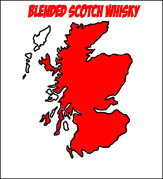


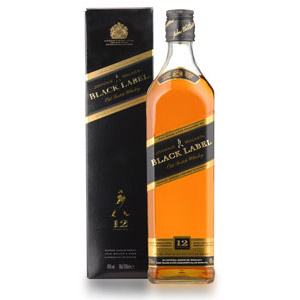
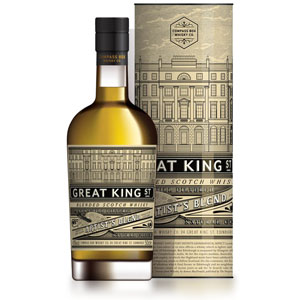
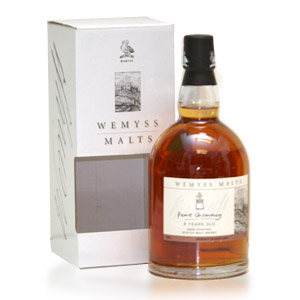
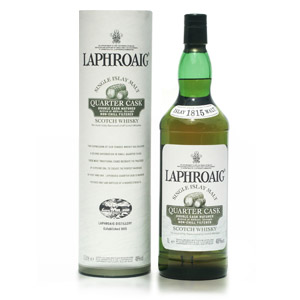

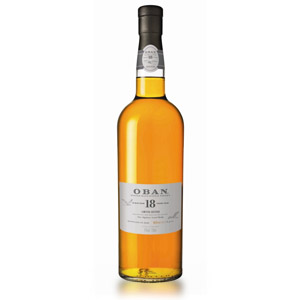
Your suggestion for blending a ‘better Black Label’ is essentially what Green Label – which has been discontinued, although you should be able to find bottles of it until next year – is composed of: Talisker, Linkwood, Caol Ila, and Cragganmore.
From what I’ve read Oban isn’t used in any blend since the distillery produces so little malt. So Oban has the distinction of being the only single malt in Diageo’s portfolio that is being exclusively sold as a single malt.
Eric, now that you mention it, I remember reading the same thing. I’m not sure there’s an official statement from Diageo regarding the principal malts in JW Black – all the info I could find was on past blog posts and forums. I’ll remove Oban from the list above – thanks!
Or get a bottle of Isle of Skye, which does have Talisker at its heart without being much more expensive.
Agreed. Better than the JW Black is the Isle of Skye 8-yr old. For the same money, a clearly superior blend and an excellent “go to” Scotch.
Thank you!
At risk of making a fool of myself here where everyone hates JW, I am going to say this regardless: I think JW still holds some value. For all intents and purposes, JW Blue is what got me into scotch and I shifted immediately to single malts. Yes, I’m sure their target audience is hilariously dislosed in company advertising meetings but clearly, by the size of their sales, it is working.
Martini – I don’t think I said I hated JW; the Green Label is fantastic, and the Black Label is, in my mind, fairly decent as well, I was just pointing out that the ScotchNoob’s suggestion for a better Black Label was very close to the actual recipe for Green Label. 😉
True. My apologies!
The Johnnie Walker Double Black is a far superior product compared to the standard black label imho. Price point is right about $35. Worth buying if can find it
I agree 100% with everything you say, Noob – but will stand here as a whisky geek & raving snob, and state to the world that I like Johnny Walker Black Label (JWBL) and always keep a bottle on hand (granted it’s usually a 375ml). I use JWBL as a touchstone for value and a flavor calibrator when reviewing blends and inexpensive entry level single malts. I regularly put JWBL up head to head and it often does very well.
But that’s not the reason I drink JWBL. The reason is that it is ubiquitous and interesting whiskies are not. I find myself, from time to time, at bars (particularly of the airline cart or wedding/bar mitzva variety) that just don’t have interesting whisky on hand. If the choice comes down to Dewars White Label, Passport, Vodka, or JWBL I’ll take the Black Label every time. Each time I’m in that situation I end up having a fairly decent Scotch experience. JWBL is designed to taste like the highly averaged idealized simulacrum of the “Highland Scotch Whisky” flavor profile. To that end Diageo succeeds, much in the manner that Heinz tastes like “ketchup”. It’s not gourmet. It’s mainstream and aims for and nails the very middle. There’s a place for that. If you want to taste how truly decent JWBL really is, taste it head to head against Johnny Walker Red Label! Huge difference!
What was it Christopher Hitchens said about Black Label, and why he only ever drank Black Label? I think it had something to do with its ubiquity and the fact that even ruthless dictators, who had the option of drinking anything they wanted, drank Black Label…
Even though I’ve whined at the Scotch Noob before for calling Black Label “bottom-shelf”, I think this review is basically spot on.
However, just for context, I would like to remind everyone, like I did last time, that JW Black Label is still around the (perhaps) middle of the quality/price histogram of blended Scotches available… maybe in the 30th percentile or so of Scotches in general? There still exist dozens of cheap Scotches that are dwarved by Black Label’s quality. And so, as Josh said, sometimes I feel fortunate at being able to grab a glass of Black Label at a shitty hotel or wedding bar…
Nobody tastes the sherry in JW Black? I find it very strong (through the veil of grain whisky), but maybe I just taste the caramel 🙂 As for the brand, I have a lot of admiration for JW, based primarily on JW Green and Gold, which are exceptional whiskies and best mass-produced blended whiskies/malts.
At $50 per 750mL, this isn’t a terrible buy here in Ohio. Our liquor selection is….well…..fairly pathetic compared to other places (and it seems way higher priced).
But for what it is, and the selection available, I do enjoy JWBL. Is it terrible? Certainly not. Is it the best? Certainly not. Will it always have a place on my shelf? Definite yes!
For the same price I’d rather have a Macallan 12yo but sometimes that urge for JWBL just cannot be fulfilled. I can’t put my finger on it, but there is something I really enjoy about this scotch.
IMHO, that intangible that you’re describing is jwbl curse and blessing.
I honestly think the blenders drink far more than us and wind up dumping extra rich premo stuff in one batch and then over compensate in the next. I’ve stopped drinking it and started blending my own. My 2cents
Ask if your local liquor store will order whatever you want – often they will. I’m from SE Ohio and my local store orders whenever I request it.
I really wanted to try Ardbeg Uigeadail and couldn’t find it locally or in the D.C. and Philly area on a trip. Asked the local store and he had 6 bottles in less than 2 weeks.
Really interesting review, and I agree with much of what you write. I’m with the other Josh above, though, in the tend-to-keep-a-bottle-in-the-cabinet camp. It’s such a comfortable drink to have on hand when you want to unwind without making too much of an effort.
On something of a side note, you’re exactly right about up-to-date, comprehensive whisky-related statistics being surprisingly difficult to find online!
I think blends such as jwbl and dewars white label are not made to withstand such criticism. I don’t think your supposed to hold products like these up to a microscope and pick out each and every one of their faults. These products are made (I know this may sound like blasphemy) for consumption with ice and/or soda. I love nothing more than to take a blend (jwbl, dewars, grouse, chivas, etc) throw some ice on top and sit out on my porch and let the world melt away. Just one mans humble opinion.
@Booze Cruiser
You are totally right on two points: Blends like this are NOT intended for drinking straight and analyzing. Also, they are definitely meant for mixing – not blasphemy at all. I have variously stated elsewhere on this blog – although probably not as frequently as I should – that I do not enjoy any kind of whisky mixed, and therefore cannot review blends on that basis. Instead, as some people do drink blends straight, and others are interested in the baseline quality of the products that go into their mixed drinks or over ice, I review them to the same standards (and using the same procedure) as single malts. It may be worth noting that some “mixable” blends are quite good straight, and do stand up to this level of scrutiny: Great King Street Artist’s Blend and Bank Note, for example. While JW etc. are “meant” for covering up with ice or soda or water, some similar products are fundamentally better, and thus get a better review.
I enjoy JW Double Black ($35) neat or with a bit of water, so it rates much higher on my blend scale than most others. Same for JW Swing ($45) and Buchanan’s 18 YO Special Reserve ($55). Very good blends with increasing quality with price. The 18 SR is quite good as a leather armchair/smoking jacket style blend. I’d love a review of these!
It’s pretty easy to pick out the professional amateur scotch drinkers – they all bash the hell out of the popular blends, single malts and pretty much anything that is modestly priced, and this review of JW Black is proof positive once again.
To all you new scotch drinkers out there, it’s not rocket science, although to listen to some people they’d have you think so, with all their sniff and snoot and ridiculous descriptions, just pick the glass up and drink, it’s that simple, don’t think about it, just enjoy, it doesn’t matter if it taste like cookie-dough, or has hints of new mowed lavender, just sip and don’t over think it and you’ll way ahead of these scotch snobs.
I agree that it’s important for everyone to try everything they can get their hands on, but your words make it sound like nobody should ever try to compare products to see what they like best, or what might be worth their money. Every scotch is not equivalent, some are better than others. Also, peruse my site and you’ll discover plenty of reviews of value-priced whisky that I heartily recommend. This happens to not be one of them.
I recently tried BL, neat, and it had been well chilled. I liked it. I will say that I am brand new to scotch. Some of my colleagues drink scotch, and at 55 I decided to try and understand the allure. They are primarily single malt drinkers, so that has been my intro to the scotch world. I have tried Glenlivet, Glenfiddich, and most recently Balvenie double wood. I will say that I liked the BL so much that it will be the second bottle of scotch to go in the liquor cabinet, right next to the Balvenie. Actually, the BL will go in the fridge.
You said it SnobsSnob! JWBL is a great scotch!
My dear friend you are correct in your assumption that I think people should not compare products, why bother ? Just drink them and choose the ones you like and spend you time enjoying instead of comparing and analyzing.
I see people all the time, they pick up glass and immediately go into this predictable silly routine, all the sniffing and sipping trying figure what it tastes like to impress their counterparts, cookie dough, butternut, toes nails, monkey dung, geez what’s next moon rock moss – It tastes like scotch – just drink it already.
And true all scotch is not equivalent, but it’s also not nearly as different as some would lead us to beleive. The vast difference in the price of one 12 year as compared to another is 99 percent due to personal taste and marketing – simple as that.
How many 12 year malts when cheap got trashed by reviewers, a couple years later their price goes up and then the reviewers love them – go figure LOL
Because reviewing and comparing is fun. If you don’t like it, why are you bothering with reading this blog and commenting?
Hey scotchnoob if you get the chance try to grab a bottle of the gold label 18 year old not the gold label reserve and do a review of it i would love to see your opinion of it.
I have just recently started drinking scotch, my first taste was Johnny Walker Blue. I have tried many other brands, both single malt and blends and I have to say, although I loved the Blue Label, it was not worth the money to me. I have recently tried the Green Label replacement, Johnny Walker Platinum Label. This blend is my favorite and is half the cost of Blue Label. I would love to see your review on the Platinum Label and if you find it to be a good scotch. It is much better than the Black Label as well, finishing up my Black Label as we speak to move on to the Platinum purchase.
Since there is no review of the Green Label up yet, I’ll ask here – is there any reason to buy a bottle or two of Green while it’s still available? ($65 locally)
I’m not sure that I’m missing much by sticking with a nice selection of Islay and Speyside single malts, but there’s always that fear of missing out on something half decent. 🙂
I’ve never had the green, but I feel pretty confident that it lies between the blue and gold in terms of quality. I considered buying a bottle or two against possible future demand, but decided against it on the grounds that I’d rather drink $130 worth of better single malt now, than own $130 worth of “just OK” blend later. Of course, it could become valuable due to its rarity, but remember that you’re certainly not the only one with the idea, so that could offset its potential value.
All that said, because of the global whisky boom, whisky in general is becoming more and more watered down and less and less aged, and barrels that used to be sold off on the bulk market are finding themselves dumped into premium blends. Green label at $65 now might represent a better deal than $65 worth of blended scotch in 5 years. If you enjoy Green, that alone might be a reason to stash some. I personally would rather drink Bank Note.
(Yes, I know Green is all-malt, but I still think Bank Note is formulated using higher-quality ingredients for less than half the price.)
Well I’m not claiming to be an expert by any stretch of the word. But I’m a fan of JWBL when the mood calls for a mixed drink and I don’t want to pour a bourbon.
With that being said, no it does not compare to a single malt. The two are apples and oranges.
I am brand new to scotch. I have been curious about it for quite awhile, but only recently purchased my first bottle, JW Black. I had read that it is a good introduction into scotch. However I am not particularly impressed. I do enjoy the nose (after the initial alcohol smell), but beyond that, I dont find it very good. I know that the consesus is that blends don’t really hold a candle to single malts. I tend to like my beverages with a little sweetness, so I was wondering if anyone has any good suggestions for me. I am taking a trip to Canada in a few months and will be stopping at the duty free store. So I intend to save a little money on my scotch by buying it there.
Hi Mike. I don’t know whether the Duty Free stores will save you money or not, as I don’t do much (any) international travel. Also, Duty Free stores often carry “exclusive” bottlings that are only available in duty free, and are usually pricier because of their exclusivity. That said, they probably have the standard bottles as well. You might start here: //scotchnoob.com/2012/02/23/picking-your-first-single-malt-scotch/ or you could go with one of my favorites: GlenDronach 12 (sherry-aged), Balvenie DoubleWood 12 year (half sherry aged), or Oban 14 (sweet and light). Cheers!
Thanks for the suggestions. I’ve been eyeing the DoubleWood since I’ve read good reviews. Turns out the duty free store website shows they have it, at $10 less for a 1L bottle than the local liquor store charges for 750ml! So I will definitely be purchasing a bottle. I will be sure to post on that when I try it!
Consistency is the principal goal when blending whiskey, whether it is scotch, bourbon, or rye. The more consistent the components are, the more consistent the blend can be. Consistency in distilling is a skill mastered by a distillery as a whole. They are rewarded with higher prices. This is why top shelf blends are more expensive: they are consistent and appealing. However, the only distinction between the 2nd and 3rd shelf, or the 3rd and 4th shelf, is the advertising budget. You will find distinct differences between 2nd and 4th shelves, both in appeal and consistency. So I repeat: consistency is high praise for a blend.
Now having said that, the emergence of single malts and, for bourbon and rye, single casks, has revealed how radically different the components can be and how varied those components can be from year to year. Not surprisingly, the most favored single malts and casks come from the most consistent distilleries and have the most interesting flavors.
Make mine a Lagavulin, but if all you have are blends, JWB, please.
[…] stairs or elevator to the second floor. The lineup for the evening: – Macallan 12 – Glenlivet 12 – Johnnie Walker Black – Glenlivet Nadura […]
Well at the risk of the ire of Snob’s snob who came on a review site and was apparently baffled that there would be reviews and therefore comparisons; Scotchnoob once again you nailed the review. Had it the other night and it really wasn’t terrible. Which- is hardly trashing it as I believe even you weren’t doing. It’s not that it is what it is that bothers me, it’s just that look that a JWBL owner seems to get in their eye that indicates they think they hit something really cool or special. And maybe to them it is. For me, and admittedly I’ve only been hitting malts for 10 months now, it was -good- but just good. To me, a coffee roaster it’s the equivalent to buying “fresh roasted” at a super market; or roasting my own. The one is good, but tastes for a lack of a better term “safe” and mass produced. The other is truly vibrant and fresh, with depth and character that simply may not appeal to every one. JWBL is such and example of a “safe” whiskey. It’s biggest problem simply may be that for 25$ more you may never want to go back to it again. Apologies for wrong words and misspelling; it’s the ipod not the scotch sadly.
Thanks for the comment, Tim – fixed the typos you indicated. For me, Bank Note blended scotch is so much better than JWBL and is cheaper. I despise paying extra for a “name” – I feel that Johnnie Walker in general has about a 25% markup (or more) just for the name. That’s what bothers me. 🙂
I usually agree with most of your comments, buy I just have to disagree with your overall view of JW Black. I love it – I really do. In fact, I believe it’s the best blended scotch currently available. My only negative with JW Black is the price. I have seen close to 30% price increase in less than three years – which puts it in the $45 range and therefore very close to the lower end single malts.
Indeed Robert. In fact, it’s part of my philosophy (and the way I write my reviews) that price has a big effect on my opinions. If a very tasty whisky is $500 a bottle, it gets a bad review. If the same whisky is $50, it will probably be recommended. If it’s $20, it will be a Must Buy! This is part of the reason I regularly recommend Bank Note 5 year blended scotch as my “go-to” blend, above all of the mass-market blends including JW Black. Side-by-side, the JW Black is only slightly better (to my palate) than Bank Note, but almost double the price. Easy decision, for me. Cheers!
I actually really like JWBL. I started drinking single malts a few months ago. And learned how to appreciate and distinguish flavours on my palate. And though I’m still not incredibly sophisticated palate yet, I found that in Ontario, Canada many of the single malts scotches in about the 12 year range are greater than or equal to JWBL in price. But the experience is much more satisfying with JWBL. I either had to spend a lot more 15-18 year old single malts to compete with the smoothness or spend a lot more on the heavy smoky and peaty singles to get better than BL. So value for money I stock this in my bar constantly.
“factory mass-produced, lowest-bidder, Penny-squeezing corporate swill. I personally don’t believe that quality and greed can coexist in the same producer, whether that producer is making whiskey, wine, cheese or furniture.” – HA! Beautifully written! You are now my favorite writer! I absolutely agree! You listed the finest things in life,,, with the exception of cars and homes,, but I get it! COMPLETELY!
Thanks for the kind words, Steve! Though to be fair, it’s too easy to pick on Diageo. Cheers!
I just picked up JW Double Black on sale for $27. I was afraid it would be terrible after drinking nothing but single malts for a while but it’s actually quite good in my opinion. Very enjoyable neat how I like it and makes for a pleasant companion while watching soccer. What I like about blends is you can relax and drink without paying much attention to the nuances or the price. Like one commenter said: just let the world melt.
Nathan
So in your opinion, what “inexpensive, easy to drink” blend would you recommend most if not JWBL?
Dave
Hi Dave,
My go-to blend is Bank Note 5 year. I think it’s better in every way. If you want it a little smoky, pour in some Laphroaig. 🙂 Another good option is Great King Street: Artist’s Blend, but it’s a bit more money and not a fair comparison.
Artificially colored corporate swill (well put) – with no distinct identity. Amazing how this cut above JW red gets defended so vehemently. “Oh, but it is for mixing.” That is, to me, a cop-out. If you’re mixing your scotch, you’re drinking poor-quality liquor.
This is probably blasphemous to the JWB people as well as to the Single Malt people, but I usually put a dash of an Islay malt into my JWB dram to give it a bit more peatiness.
I don’t see anything wrong with that. I’ve been known to kick up my Bank Note with some cask-strength sherried malt like Aberlour abunadh. Home blending can be fun. 🙂
Scotch snobbery strikes again! Is it the most complex scotch out there? No. Is it the best value? No. Is it “craft”? No. It is accessible and unthreatening, with enough character to make it interesting. Definitely miles above stuff like Ballantine’s Finest, and if not for, I wouldn’t be drinking single malts, today.
A lot of your reviews err on the side of negativity and judgmental. JWB does the job for millions across the globe. It’s far from rotgut, and for most people, ie non-whisky geeks, good enough. There’s a huge bias against blends, I think, because people are already coming from it and expecting it to match up with whatever flavor bomb malt. Don’t do that.
I love variety, and would grow bored if forced to limit myself. Still, I see myself stocking up on JWBL in the future.
I have many positive reviews of blends – look for my Bank Note review, which costs distinctly less than JWB and which I would prefer for both mixing, over ice, and neat. For anyone who finds that JWB “does the job”, why are you reading reviews on the Internet? Be satisfied and don’t seek out differing opinions to argue with.
Jeez. Get over yourself. I don’t suppose that “penny pinching corporate swill” mindset biased your review, huh? Well, at least you put it out there to take into account.
If any real scotch newbie is reading this, please don’t let it put you off trying JWB. Keep an open mind and just taste the whisky.
Sure, taste is subjective and maybe this won’t be your favorite. But if you do taste “coal tar on a buttered scone”, “vodka-esque off notes” and “burnt match head” in JWB, maybe whisky isn’t really for you.
And if it’s $50 at your local store…you’re shopping in the wrong place (unless you’re in Canada maybe). It’s $32 where I shop and it stands up to anything in that price range, and a lot that costs more, many single malts included. But then that’s just my opinion.
First, I said “$50” nowhere in my review. I state in at least two places that it’s around $30, so I’m not sure where you got $50 from. Second, I fail to see how me not liking JWB (and, incidentally, liking a wide swath of other whiskies, including many that are cheaper than JW) means that “whisky isn’t for me”. If you have a burger at a burger joint and say that it tastes over-cooked, do you expect someone to tell you that maybe burgers aren’t for you? “Oh come on”, indeed.
I started my scotch career with JW Red, probably for the same reasons a lot of other people did so: it was available and affordable on a college kid budget. Eventually I gave Black Label a spin, and now I’ve progressed into that most expensive of hobbies: single malt scotch whisky.
But I’ve never entirely lost my soft spot for Johnnie Walker, and while my preferred tipple from the Walker stable is Green Label, it seems I go through at least one handle of Black Label per year. Availability and affordability never go out of style.
I find this quote by Jim Murray (ripped from Jason Debly’s blog) to be a very compelling defense of Johnnie Walker’s most famous blend:
“Each day I have some 6,000 whiskies to choose from for a social dram if I want one. And at least once a week I will sample a Black Label. While the single malt revolution continues unabated, it is a shame that whisky lovers do not use this as a yardstick. They will find that very few malts can match this for complexity. This is the Savoy, the Everest of Deluxe Whiskies: there is not a blender who would not give their right arm – or even their left one – for the recipe of this supreme whisky. The trouble is, even if they had it, they would then struggle to find the stock. It represents the best value for money of any whisky in the world.”
That’s a bit of an overstatement of my feelings on Black Label, but not by much.
I agree that JW certainly isn’t the epitome of quality Scotch whisky… That said however, JWBL is just over $40 for a 1.75L at my local total wine. That comes out to about ~$18/normal 750ml. at the sub-$20 range, I find this to be a very acceptable, reasonably decent/good blend. It’s hard to find better quality without spending 20-30% more, and JWBL just hits my threshold of good enough to drink straight to whet my whistle/prepare my palate or just get a buzz without breaking the bank. That’s where I put it personally.. along with Teachers and Dewars 12. The SM equivalent for me is Glenfiddich 12; not particularly complex, but it’s not intended to be. I also find JWGL to be a decent upscale blend (malt) for the money. Both are also great for rationing out more expensive malts such as Lagavulin and Ardbeg. Just add a splash of such malts to the JW blends, and you get 70% of the upscale single malt experience for about 30% of the cost. Cheers!
Ok so ranking on this blend is like putting down chain steak houses because they are popular. Sure you can find a better product for more money but the core quality is there and the consistency of JWB is the selling point. Its better than most blends, carries a 12 yr age statement and delivers a smooth smoky honey taste that most scotch drinkers just flat out enjoy. Its a “safe” choice in the sense that there is a high probability your scotch drinking guest or friend or whomever will like it. Even a seasoned drinker who likes to dissect and analyze every aspect of a scotch/bourbon/rye can appreciate what JWB brings to the table. Of course there are individual exceptions(in this blog bank note is presented) but overall JW Black Label is a very good tasting, good value blend that should not be punished for its popularity
Thanks for the comment! I do not believe that I punished JW Black for its popularity. I think I reviewed it based on its flavor (I don’t rank anything, if you noticed, there are no numbers or scores) and then talked about its popularity. If I’m wrong about that, well, I am human and I err. I still don’t recommend JW Black (popular or not) due to my belief that there are better options out there. If I talked about its popularity, it’s in an effort to counter the marketing and suggest to newcomers that Johnnie Walker is not the pinnacle of taste the marketers (or brand loyalists) would like you to believe. The worst-case scenario is that a newbie buys JW Black, figures it’s the best he/she is going to do because Green/Platinum/Blue are out of reach financially, and then stops exploring the market. I’d rather err on the side of slagging a popular brand than supporting that possibility. Cheers!
“factory mass-produced, lowest-bidder, penny-squeezing corporate swill. ” This is what you said prior to your review. It seems to me like you were biased going in due to the popularity of JWB. I agree with you single malts are better however I quite enjoy JWB and feel as a blend it is one of the best. When I said ranking I meant it as a verb(rank-to insult or make fun of) Im with you on your scenario and agree JWB is most likely overrated for what it is but for 30 bucks its solid and can serve more as a gateway to higher end scotch . Didnt mean to offend, I enjoy your reviews.
Greetings,
Have you, or are you going to review the new Double Black any time in the future??
I had it at a whisky show, and I remember it being markedly more smokey than Black Label. I haven’t acquired a sample of it to review yet, but I will add it to my “to do” list. Cheers!
My wife used to come back from business trips with two bottles of JWB from deals at the airport duty free. As I was new to whiskey ( scotch) at the time I was thrilled. I live in Canada ( BC ) and liquor prices are horrendous. I don’t have any issues with JWB but the price point in my neck of the woods discounts it from contention solely due to the fact that it’s worth it to spend the extra 20, 30, 40 dollars on a quality single malt.I won’t spend $70 bucks on a whiskey I would mix with soda.